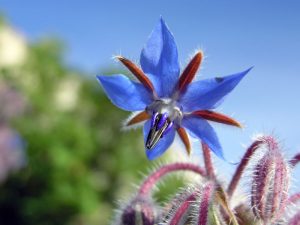How to Grow Borage – A Guide to Growing Borage
 Borage is a hardy annual that’s easy to grow from seed, and will liberally self-seed if flowerheads are left on over winter. The star-shaped, startling blue flowers are particularly beautiful and plentiful, but is best used fresh as it does not dry well.
Borage is a hardy annual that’s easy to grow from seed, and will liberally self-seed if flowerheads are left on over winter. The star-shaped, startling blue flowers are particularly beautiful and plentiful, but is best used fresh as it does not dry well.
Borage plants average about 75 cm (30 inches) in height, about half as much in width, and can be a bit straggly in very poor soil. It can be grow in pots or containers, but prefers space in the veg plot or flower bed where it’s an excellent bee attractant. The leaves are covered in stiff white hairs on branched hollow stems that will easily snap in strong winds, so growing them in self-supporting clumps is recommended.
Recommended Varieties of Borage
Primarily the blue-flowered plant is grown, though a white-flowered borage is available.
Borage Pests and Problems
Borage is one of the few problem-free herbs to grow other than occasional Japanese beetle problems.
Due to their tall, hollow stems, borage plants can snap in strong winds so overcrowding the plants to self-support is highly recommended.
Sowing and Growing Borage
- Direct sow the seeds 1/8” deep into fine, well-worked moist soil with some rotted manure in early spring, March–May.
- Space seeds about 15 – 30 cm (6 – 12 inches) apart. Plants do best when allowed to grow in thick clumps for support. Borage is shallow-rooted and easily controlled by pulling.
- Don’t let the young plants dry out.
- Borage prefers partial sun but will grow almost anywhere.
- Self seeds liberally and flowers most of the season
- Particularly good grown with hyssop or near strawberries to attract bees and butterflies
Harvesting, Eating and Storing Borage
Pick the flowers and the young leaves as and when you want to use them. They do not store well. Borage flowers are often used to replace candied violets for baked goods. The flowers are also a key ingredient for Pimms, as well as an attractive garnish.
Borage’s mild cucumber taste blends well with cucumbers in a salad.
The young leaves, in moderate amounts, are nice in a mixed leaf salad, or sauteed like spinach.



